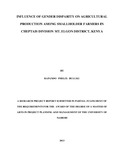| dc.contributor.author | Buluku, Rapando Phelix | |
| dc.date.accessioned | 2013-08-13T08:13:50Z | |
| dc.date.available | 2013-08-13T08:13:50Z | |
| dc.date.issued | 2013 | |
| dc.identifier.citation | Master Of Arts In Project Planning And Management, University of Nairobi, 2013. | en |
| dc.identifier.uri | http://erepository.uonbi.ac.ke:8080/xmlui/handle/123456789/56086 | |
| dc.description.abstract | The inequality between women and men is seen both as a human and people –centered
factor that hinder development. This study sought to find out how gender disparity influence
smallholder agricultural production in Cheptais division of Mt Elgon district. According to the
study, gender disparity is the discrimination or differential treatment based on gender and in
most developing countries the discrimination tends to favor men at the expense of women, who
are often a crucial resource in agriculture and the rural economy. Involvement of both women
and the youth in agriculture and the benefits they derive from it has been shroud in gender
stereotypes that propagate male dominance. A number of development programs with a broad
goal of empowering the community hardly take into consideration gender dynamics in their
development programs. This trend is observed in policies, strategies and plans guiding
development work. The overall development of a nation calls for maximum participation of both
men and women. Gender inequality exacerbates food insecurity, malnutrition and poverty. The
proportion of women in Kenya accounts for 51% of the population while the rest are men. This
means that of the total potential human resource available for utilization in national development,
women form more than half. The objectives of the study included: to investigate the extent to
which gender disparity on access to and control of productive resources influence agricultural
production among smallholder farmers, to establish the level at which gender disparity on access
to extension services influence agricultural productivity and to identify strategies to address
gender disparity to influence smallholder agricultural productivity. The study answered the
following research questions: To what extend does gender disparity on access and control of
productive resources influence smallholder agricultural production? What level of gender
disparity on access to extension services influence smallholder agricultural productivity? Are
there strategies that can be used to address gender disparity to influence smallholder agricultural
productivity? The study utilized descriptive study design that involved administration of
questionnaire and interviews to a sample of 361 respondents drawn from a population of
approximately 6000. Clustered sampling method was used to select respondents and data was
analyzed using Statistical Package for Social Scientist (SPSS). The findings of this study
indicated that women had more access to agricultural resources but male had control and
decision making authority on the resources with only 41(11.4%) of the female out of the 361
respondents interviewed having control over land. Control over resources positively influence
productivity and women who had access to resources showing to be more effective in
productivity as compared to male. The study also found that women had more access to credit as
compared to men due to the fact that women were more involved in VSLAs that advance credit
to members. The study made the following conclusions; control over income from the farm and
ability to access extension service had the greatest effect on land productivity as compared to
having authority on how land is used and that capacity development programmes for advocacy
purposes could reduce the effect of gender disparity on smallholder agricultural productivity.
This study recommends that gender experts together with all those with information on gender
mainstreaming in agricultural productivity should engage other stakeholders in sensitization and
capacity development efforts. Also recommended is adoption of gender sensitive curriculum that
accommodate women and consider their work load by extension providers. Further research
should be carried out to analyze the factors promoting gender disparity in access and control of
productive resources. Another research should be undertaken to determine the role played by
extension services in reducing gender disparity in smallholder agricultural production. | en |
| dc.language.iso | en | en |
| dc.publisher | University of Nairobi | en |
| dc.title | Influence Of Gender Disparity On Agricultural Production Among Smallholder Farmers In Cheptais Division Mt. Elgon District, Kenya | en |
| dc.type | Thesis | en |
| local.publisher | Department of Extra-Mural Studies | en |

